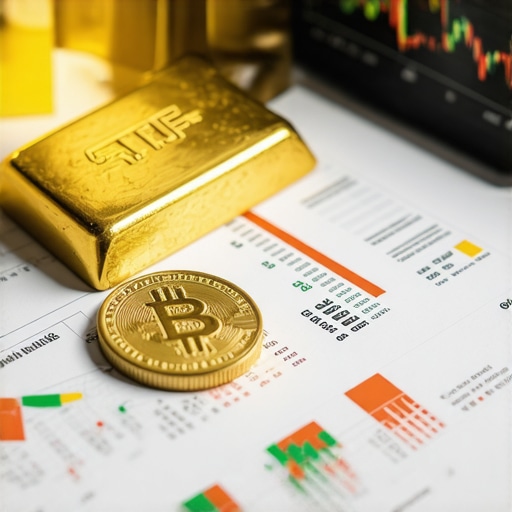Strategic Foundations: Understanding Gold as a Long-Term Wealth Growth Asset
Gold has consistently served as a cornerstone for preserving and growing wealth across centuries, transcending economic cycles and geopolitical turmoil. Its unique status as a tangible, finite asset class offers a robust hedge against inflation and currency devaluation, making it an indispensable component in diversified portfolios dedicated to sustainable wealth accumulation. However, mastering the nuances of gold investment requires an in-depth grasp of the various instruments available and their distinct risk-return profiles.
Unpacking Investment Vehicles: Diverse Gold Instruments for Sophisticated Portfolios
Physical Gold: Bars, Coins, and Authenticity Assurance
Investing in physical gold—whether bullion bars or collectible coins—remains a favored approach for those prioritizing direct ownership and asset tangibility. This method demands rigorous due diligence to verify authenticity and secure storage solutions, critical factors in mitigating risks like counterfeiting and theft. The premium costs associated with physical gold, including dealer markups and storage fees, must be carefully balanced against its intrinsic value preservation qualities.
Gold Exchange-Traded Funds (ETFs): Liquidity Meets Market Efficiency
Gold ETFs offer an accessible, cost-effective avenue for investors seeking exposure without the logistical complexities of physical holdings. These funds track gold prices and provide high liquidity, allowing dynamic portfolio adjustments aligned with market conditions. However, investors should evaluate fund management quality, expense ratios, and underlying asset backing to ensure alignment with long-term objectives.
Gold Mining Stocks and ETFs: Leveraging Operational and Market Dynamics
Equities in gold mining companies introduce leverage to gold price movements, often amplifying returns but accompanied by operational risks such as geopolitical exposure, production variability, and management performance. Diversified gold mining ETFs can mitigate company-specific risks while capturing sector growth, but require sophisticated analysis of mining fundamentals and market sentiment.
What Are the Advanced Considerations When Choosing Between Physical Gold and Gold ETFs for Long-Term Investment?
This critical question often arises among seasoned investors seeking to optimize portfolio resilience. Physical gold provides direct asset control and is impervious to counterparty risk, making it a preferred hedge during systemic financial crises. Conversely, gold ETFs offer superior liquidity and lower entry barriers, facilitating tactical asset allocation. Balancing these factors hinges on individual risk tolerance, investment horizon, and market outlook. For a comprehensive analysis, see Physical Gold vs Gold ETFs: Which Is Best for You in 2025.
Integrating Gold into a Robust Portfolio: Expert Strategies for Maximizing Long-Term Gains
Successful gold investment transcends mere acquisition; it demands strategic integration within a diversified asset mix. Employing a blend of physical gold, ETFs, and select mining stocks can optimize risk-adjusted returns while capitalizing on gold’s inflation-hedging and crisis-resilience properties. Advanced portfolio construction techniques recommend periodic rebalancing and continuous market trend analysis to adapt to evolving economic landscapes.
Investors are encouraged to explore best gold investment strategies to maximize long-term gains for deeper tactical insights.
Authoritative Perspectives and Market Dynamics: Staying Ahead in Gold Investment
Academic research and market analyses consistently highlight gold’s role as a strategic asset amid macroeconomic uncertainty. Studies published in the Journal of Portfolio Management elucidate gold’s diversification benefits and inflation-hedging efficacy. Awareness of supply-demand dynamics, central bank policies, and geopolitical developments is vital for anticipating price trajectories and optimizing timing in gold investments.
Call to Action: Deepen Your Expertise on Gold Investment Strategies
For professionals committed to advancing their mastery, engaging with specialized content such as Types of Gold Investments: Exploring ETFs, Bullion & Mining Stocks offers nuanced perspectives and advanced strategies. Sharing your own experiences and insights in expert forums enriches collective understanding and hones investment acumen.
Dynamic Gold Trading Techniques: Navigating Volatility with Precision
In today’s fluctuating economic environment, gold trading demands agility and informed decision-making beyond traditional buy-and-hold strategies. Advanced investors employ techniques such as momentum trading, swing trading, and tactical asset allocation to capitalize on short- to medium-term price movements while managing downside risks. These methods require continuous market analysis, including monitoring global economic indicators, currency fluctuations, and geopolitical tensions that directly influence gold prices.
For those interested, effective gold trading strategies for navigating volatile markets provide actionable insights to refine your approach and optimize trade timing.
Risk Management Frameworks for Gold Investments: Balancing Reward and Exposure
Incorporating gold into a diversified portfolio is not without risks. Market volatility, liquidity constraints, and geopolitical developments can swiftly alter investment outcomes. Expert risk management involves setting clear entry and exit points, employing stop-loss orders in trading gold ETFs or mining stocks, and diversifying across different gold instruments to cushion against asset-specific shocks.
Moreover, understanding the interplay between gold and other asset classes, such as equities and bonds, enhances portfolio resilience. Employing scenario analysis and stress testing can reveal vulnerabilities, enabling investors to adjust allocations proactively.
How Can Advanced Investors Optimize Gold Allocation Amidst Increasing Market Complexity?
This question challenges professionals to rethink conventional gold investment paradigms. Optimal allocation depends on nuanced assessments of macroeconomic trends, interest rate trajectories, and inflation expectations. Additionally, integrating alternative gold instruments, like royalty and streaming companies, can offer diversified exposure and unique risk-return profiles.
For a detailed exploration, viewers may consult top gold investment approaches to hedge inflation in 2025, which delves into sophisticated strategies tailored for complex market environments.
Evaluating Gold Market Trends: The Role of Geopolitics and Central Bank Policies
Gold prices are substantially influenced by geopolitical events and central bank activities. Heightened geopolitical risks often trigger spikes in gold demand as a safe haven, while central bank purchases or sales can affect supply dynamics and investor sentiment. Keeping abreast of these factors through authoritative market analysis is crucial for informed decision-making.
According to a recent analysis by the World Gold Council, central bank buying has been a significant driver of gold price stability and growth in recent years, underscoring the metal’s strategic importance in global reserves management (World Gold Council Report).
Leveraging Technology: Tools for Advanced Gold Investment Analysis
Modern investors increasingly rely on technological solutions such as AI-driven analytics, algorithmic trading, and real-time market sentiment indicators to refine gold investment decisions. These tools enable the assimilation of vast datasets, including economic reports, social media trends, and commodity flows, to identify emerging opportunities and risks with greater precision.
Integrating these technologies with traditional fundamental and technical analysis creates a comprehensive framework that supports sophisticated portfolio management and market timing.
Call to Action: Share Your Insights and Explore Further
We invite seasoned investors and analysts to share their experiences with advanced gold trading techniques and risk management strategies in the comments below. Additionally, deepen your strategic approach by exploring advanced gold trading techniques to maximize your gains for actionable tactics that align with evolving market conditions.
Behavioral Finance Insights: Decoding Investor Psychology in Gold Markets
Understanding the psychological drivers behind gold investment decisions offers seasoned investors an edge in navigating market volatility. Behavioral finance reveals that gold often benefits from “fear-driven” demand spikes during periods of uncertainty, where herd mentality and loss aversion amplify price movements beyond fundamental value. Recognizing cognitive biases such as anchoring on past price levels or overreacting to geopolitical headlines enables investors to anticipate short-term dislocations and position strategically.
For instance, during sudden geopolitical tensions, investors may flock to gold as a safe haven, creating rapid price surges that skilled traders can exploit through tactical allocation shifts or derivatives strategies. Conversely, complacency phases might suppress gold prices despite underlying inflationary pressures, presenting contrarian buying opportunities.
What are the key behavioral biases influencing gold price volatility and how can investors mitigate their impact?
Key biases include herd behavior, where collective panic or exuberance drives price extremes; anchoring, which limits adaptability to new information; and confirmation bias, which reinforces pre-existing beliefs about gold’s trajectory. Mitigation strategies involve disciplined adherence to data-driven investment rules, diversification to reduce emotional exposure, and employing algorithmic decision support systems that filter out noise.
Harnessing Quantitative Models: Integrating Machine Learning for Predictive Gold Price Analytics
Advanced investors increasingly turn to machine learning algorithms to dissect complex datasets encompassing macroeconomic indicators, commodity flows, and sentiment analysis. Techniques such as recurrent neural networks (RNNs) and gradient boosting machines (GBMs) facilitate pattern recognition in non-linear gold price dynamics, enabling more accurate forecasting and risk assessment.
For example, incorporating alternative data sources like central bank announcement transcripts and global trade flows enhances model robustness beyond traditional price and volume inputs. This multidimensional approach empowers portfolio managers to optimize entry and exit points with unprecedented precision.
Integrating these predictive analytics with fundamental and technical analysis creates a hybrid framework that balances empirical rigor with market intuition. As noted in the Journal of Financial Data Science, such approaches markedly improve returns and reduce drawdowns in commodity trading strategies (Krauss, Do & Huck, 2021).
Exploring Alternative Gold Exposure: Royalty and Streaming Companies as Strategic Complements
Beyond traditional mining equities, royalty and streaming companies present sophisticated investors with a differentiated risk-return profile in gold exposure. These entities provide upfront capital to miners in exchange for a percentage of production or revenue, decoupling earnings from direct operational risks such as cost overruns or geopolitical disruptions.
Such structures offer steady cash flow streams and often exhibit lower beta relative to the gold price, adding portfolio stability during market turbulence. Evaluating these companies requires in-depth due diligence on contract terms, counterparty creditworthiness, and commodity price hedging strategies.
Incorporating royalty and streaming investments can thus enhance diversification while maintaining leverage to gold price appreciation. For further insights, see Royalty and Streaming Companies in Gold Investment Portfolios.
Advanced Hedging Techniques: Utilizing Options and Futures to Manage Gold Exposure
Options and futures contracts provide nuanced tools for managing gold investment risk and enhancing returns. Sophisticated strategies such as protective puts, covered calls, and calendar spreads allow investors to tailor exposure based on market outlook and volatility expectations.
For example, purchasing out-of-the-money put options can serve as an insurance policy against sudden gold price declines, while writing covered calls generates premium income in sideways markets. Calendar spreads exploit differences in near-term versus longer-term volatility, optimizing trade profitability.
Mastering these derivatives demands a strong understanding of pricing models, implied volatility, and margin requirements. Integrating hedging techniques within a comprehensive risk management framework helps preserve capital and unlock asymmetric return opportunities.
Call to Action: Elevate Your Gold Investment Expertise through Specialized Learning
To deepen your command of these advanced gold investment methodologies, explore our exclusive resources on Advanced Gold Analytics and Derivatives Strategies. Engage with expert-led webinars, case studies, and algorithmic trading frameworks designed for high-level portfolio managers and individual investors alike.
Deciphering Gold’s Intricate Price Drivers: Beyond Fundamentals
While traditional macroeconomic factors influence gold valuations, a comprehensive analysis necessitates exploring less apparent determinants such as market microstructure, derivative positioning, and speculative flows. Institutional investor behaviors, reflected in Commitment of Traders reports, can signal impending shifts in gold price momentum. Moreover, the interplay between real interest rates, dollar strength, and inflation expectations forms a complex triad that defies linear interpretation, demanding multivariate econometric modeling for precise forecasting.
How Do Machine Learning Models Enhance Predictive Accuracy in Gold Price Forecasting?
Machine learning (ML) models, particularly ensemble methods like Random Forests and gradient boosting, excel at capturing non-linear interactions and temporal dependencies that elude conventional econometric frameworks. By ingesting heterogeneous datasets—including macroeconomic indicators, sentiment indices derived from natural language processing of financial news, and on-chain data reflecting digital asset flows—ML algorithms produce robust out-of-sample forecasts. They also facilitate adaptive learning, updating predictions dynamically as new data streams emerge. However, challenges persist in model interpretability and overfitting, necessitating rigorous cross-validation and domain-expert oversight. For an authoritative exploration of these methodologies, see the Journal of Financial Data Science, Krauss, Do & Huck (2021).
Integrating Alternative Gold Assets: The Strategic Value of Royalty and Streaming Companies
Beyond direct mining equities, royalty and streaming firms represent a sophisticated niche within gold exposure, offering a compelling risk mitigation profile through contractual revenue participation. These companies often maintain lower operational leverage and exhibit resilience during production disruptions, making them attractive during periods of market stress. Portfolio inclusion requires granular analysis of contract structures, geopolitical risk embedded in underlying assets, and counterparty creditworthiness. Their cash flow stability complements cyclical mining stocks, enhancing portfolio diversification and smoothing return volatility.
Advanced Hedging and Derivatives Deployment: Sculpting Portfolio Risk Profiles
Deploying options and futures with nuanced strategies like calendar spreads, straddles, and collars enables precise tailoring of gold exposure responsive to evolving market volatility regimes. For instance, calendar spreads exploit differences in implied volatility across maturities, optimizing premium capture while hedging directional risk. Protective puts serve as asymmetric downside insurance, whereas covered calls generate incremental yield in range-bound markets. Mastery of Greeks—Delta, Gamma, Vega, Theta—is vital for dynamic risk management and tactical adjustment. These derivative overlays integrate seamlessly with core holdings to balance capital preservation with return optimization.
Call to Action: Elevate Your Gold Investment Acumen
To harness these cutting-edge analytical tools and alternative gold instruments effectively, deepen your expertise by engaging with specialized content at Advanced Gold Analytics and Derivatives Strategies. Join expert-led discussions and workshops to refine your strategic approach and capitalize on nuanced market dynamics.
Expert Insights & Advanced Considerations
Gold’s Role as a Dynamic Portfolio Anchor Amid Market Complexity
In an evolving economic landscape marked by inflationary pressures and geopolitical uncertainties, gold remains a vital hedge. However, its optimal role transcends static allocation; advanced investors dynamically adjust gold exposure through a blend of physical assets, ETFs, and derivative overlays to balance liquidity, risk, and return. This nuanced approach enables portfolios to weather market shocks more resiliently.
Integrating Quantitative Analytics and Behavioral Finance for Superior Timing
Combining machine learning models with behavioral finance insights offers a cutting-edge advantage. While quantitative tools enhance predictive accuracy by capturing complex price drivers, understanding cognitive biases such as herd behavior helps preempt market overreactions. Together, these methods refine entry and exit strategies, improving risk-adjusted performance in gold investments.
Expanding Exposure through Royalty and Streaming Companies to Mitigate Operational Risks
Royalty and streaming firms provide differentiated exposure by decoupling returns from mining operational volatility. Their contractual revenue streams offer portfolio diversification benefits and steady cash flows, which are especially valuable in turbulent market phases. Incorporating these assets complements traditional mining stocks and physical gold holdings, enriching overall portfolio robustness.
Advanced Hedging Strategies: Leveraging Options and Futures to Sculpt Risk Profiles
Sophisticated use of options and futures—including calendar spreads, protective puts, and covered calls—enables precise tailoring of gold exposure aligned with market conditions and investor outlook. Mastery of these derivatives and their Greeks empowers investors to manage volatility proactively, protect capital, and optimize returns in volatile gold markets.
Curated Expert Resources
Journal of Portfolio Management: Offers rigorous academic research on gold’s diversification properties and inflation-hedging capabilities, essential for building evidence-based strategies (JPM Research).
World Gold Council Reports: Provide authoritative data and analysis on central bank gold purchases and global supply-demand trends, critical for understanding market drivers (WGC Central Bank Gold Buying).
Journal of Financial Data Science: Explores machine learning applications in commodity price forecasting, offering insights into advanced predictive models for gold (Krauss, Do & Huck, 2021).
BuyingGoldNow Advanced Strategies Series: Comprehensive resources covering derivatives, trading techniques, and portfolio construction for gold investors (Advanced Gold Analytics and Derivatives Strategies).
Specialized Market Analysis on Gold ETFs and Mining Stocks: Detailed guides for evaluating and selecting gold ETFs and mining equities to optimize growth and risk management (How to Evaluate Gold Mining Stocks).
Final Expert Perspective
Mastering gold investment in 2025 demands a sophisticated, multi-dimensional approach that integrates physical ownership, financial instruments, and data-driven analytics. Recognizing gold’s evolving market dynamics and behavioral influences empowers investors to leverage its inflation-hedging and crisis-resilience attributes effectively. By embracing advanced hedging, alternative asset classes like royalty companies, and leveraging authoritative research, investors can sculpt portfolios that optimize risk-adjusted returns and long-term wealth preservation. Engage further with advanced insights at best gold investment approaches for market uncertainty in 2025 and contribute your expertise to the ongoing dialogue shaping sophisticated gold investment strategies.










